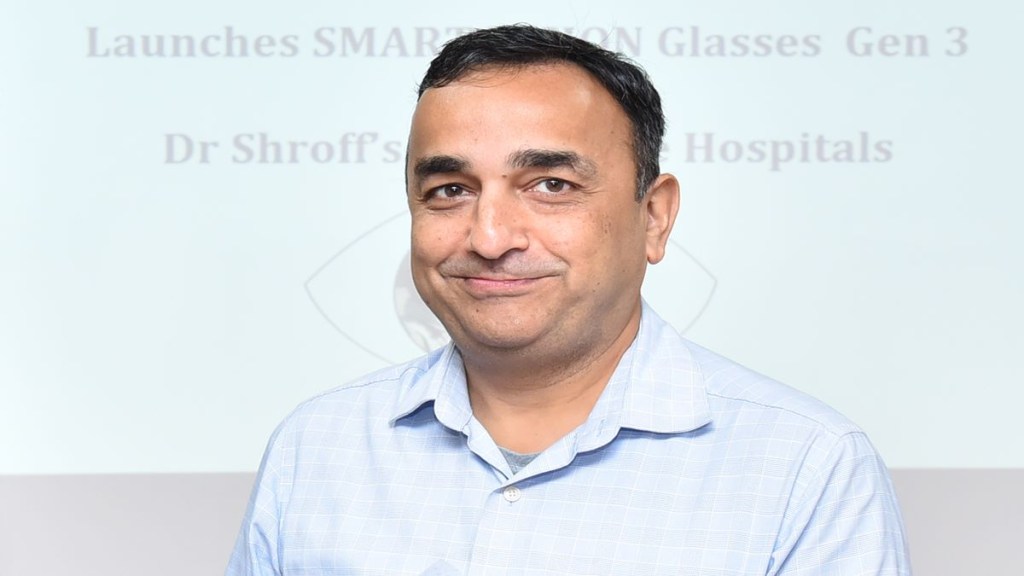Over 4.5 billion people, across the world, require corrective lenses or procedures for eye and vision problems. According to the World Health Organization (WHO) report, the leading causes of visual impairment are uncorrected refractive errors, cataracts, age-related macular degeneration, glaucoma, diabetic retinopathy, corneal opacity, and trachoma.
In India, a major population suffers from visual impairment majorly attributed to cataracts (62.6%), followed by refractive error (19.70%), glaucoma (5.80%), posterior segment disorder (4.70%), surgical complication (1.20%), and posterior capsular opacification (0.90%), as per a study published in Cureus journal.
Recently, Dr. Shroff’s Charity Eye Hospital, in association with Vision Aid India and Bengaluru-based startup SHG Technologies, has launched the third generation of Smart Vision Glasses. At the launch event, 20 blind and visually impaired individuals were provided the latest Smart Vision Glasses. Financial Express.com got the opportunity to speak to Dr. Umang Mathur, CEO of Dr. Shroff’s Charity Eye Hospital and highlighted the status of ocular diseases in India, challenges, scope and preventive measures among others. Exerpts:
Eye is an extremely important sense organ yet we still neglect it. According to you, what are the possible reasons, with respect to India, what are the possible reasons that the eye is still not a priority?
I won’t say that it is not a priority. In fact, India was the first country in the world to launch a national programme for preventional blindness and India has done quite well when it comes to eye care. Maybe, after immunisation, probably the next best programme in health is eye care. However, this comes with a catch. A lot of it is outside the government… the government being the facilitator. Almost 75 percent of eyecare intervention are outside the government. Say, sight restoration surgeries are 75-80 percent is not in the government system. However, there are cross-subsidy models like Shroff’s, Aurobindo, LV Prasad…they have shown very good models of delivery where its humanitarian kind of service delivery. India has a very robust industry of making intra-ocular lenses and other things…It’s unheard of in the rest of the world…we can do a cataract surgery in less than $25 and that’s because of the industry also. So, eye care I would say has a reasonable focus…Southern India has done better than Northern India. There are good not-for-profit players that are doing a high volume of work…the policies and financial aid has been positive on the part of the government which allowed the not-for-profit spaces to work.
In the recent years, what are some of the eye diseases that have shown upward and downward trends in India?
So, there was a recent rapid assessment of blindness which was done by the AIIMS with the NPCB which showed that still, about 65 percent of blindness is because of cataracts. Another 8 percent which is unique to India is corneal blindness and that’s because our agrarian population gets infections on the cornea. Another, 7.2 percent was because of poor outcomes of cataract surgery. So, that’s almost the third biggest cause…part of it is because they needed glasses after surgery which they never got. The quality of facilities is not uniform across India. The newer problem that we are seeing is diabetic retinopathy where people with diabetes over a period of 10 years will start developing hemorrhages on the retina. If detected in time, and if your diabetes is under control you can delay it. But patients tend to come very late. Glaucoma is another problem where large chunk of our population is at risk of developing the disease which can be prevented just by regular check-ups. So, these are common ailments. In children, is of refractive errors where a lot of children all they need is a pair of glasses. With COVID-19, screen time has increased. Myopia is on the increase majorly…that’s an emerging problem. We are seeing an increase in cases, especially among the urban population.
There are certain diseases that are specifically higher, especially in India. What is the status of eye diseases?
Yes we have more corneal infections due to our agrarian population but even cataracts are a decade earlier in India. In the West, most people would develop cataract after the age of 70. In India, a lot of people are developing cataracts after 50. We are not sure why probably something to do with nutrition or it could be UV radiation exposure. This significantly increases the burden of the disease.
There is a lack of enough doctors and specialists in India. Do you think this poses a challenge in disease management?
The bigger problem is the distribution of doctors. Around 75 percent of eye doctors are in 9 cities…Delhi-NCR would have around 20 percent of the country’s ophthalmologists. It’s a combination of issues. There is also a lot of need for creating enough paramedics.
Any words of advice for our readers on how to keep a healthy eye?
Children need to go for regular screenings. After the age of 40, one needs to have eye checkups frequently. Most eye conditions are treatable or preventable. Children need to spend time outdoors every day in sunlight and they should also limit their screen time. A balanced diet is adequate for healthy eyes.








